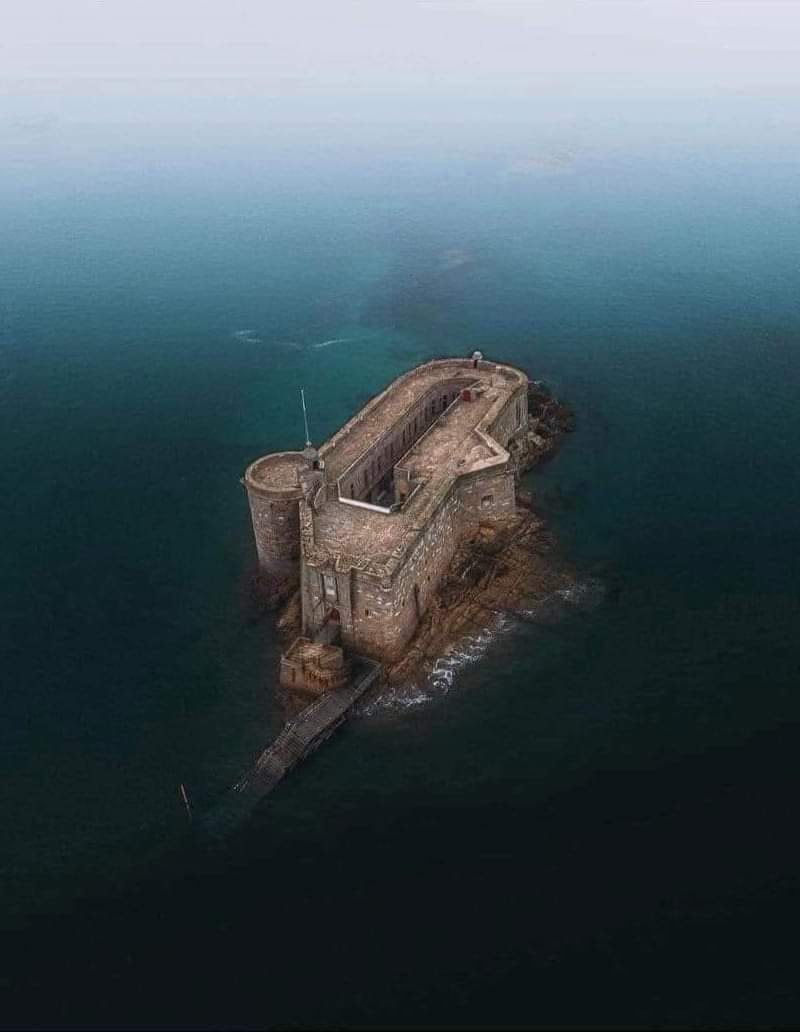The Château du Taureau is a stunning fortress situated on an islet in the Bay of Morlaix, Finistère. With a history spanning over four centuries, this remarkable structure has undergone numerous transformations, adapting to various roles throughout its existence. Initially built as a defensive stronghold, it later served as a state prison, a private retreat, a sailing school, and eventually a historic monument open to the public. Today, it stands as a testament to France’s rich architectural and military heritage.

The Château du Taureau traces its origins back to 1542 when construction began in response to a pressing threat. Just two decades earlier, in 1522, English forces had advanced up the Dossen River, reaching the heart of the Morlaix estuary. The town was looted, but the determination and resilience of its people ensured its survival. To prevent future invasions, the residents of Morlaix took it upon themselves to finance and construct a fort at the estuary’s entrance. The original fortification, known as Fort du Taureau, was relatively modest, with walls measuring just 6.5 meters in height—only half of their eventual size.
During the reign of Louis XIII, the fort’s governorship was highly coveted among the Morlaisians, often leading to disputes. However, in 1661, under the rule of Louis XIV, the French crown officially claimed ownership, converting it into state property. The king transformed it into a military garrison and prison, recognizing its strategic significance due to Brittany’s proximity to England. This geographic location often placed the region at the center of European conflicts, further justifying the need for a formidable defense system.
By 1680, renowned military engineer Vauban was tasked with strengthening the fort. He ordered extensive renovations, nearly reconstructing the entire structure except for the French Tower. The redesigned fort was built primarily from granite sourced from the nearby island of Callot, conforming to the rocky islet’s natural contours. It spanned 60 meters in length, 12 meters in width, and stood 12 meters high, covering a total area of 1,450 square meters. The new structure housed eleven casemates for cannons, along with soldiers’ and officers’ quarters, two dungeons, a kitchen, a canteen, a chapel, and latrines.
Despite its original military purpose, the Château du Taureau’s function evolved as Morlaix’s importance waned. By 1721, it was repurposed as a prison, a role it would fulfill for over 150 years. One of its most notable inmates was Louis Auguste Blanqui, a key revolutionary figure of the Paris Commune, who was confined there in 1871.
By 1890, the fort had lost its strategic military relevance and was officially disarmed. In 1914, the French government designated it as a historic monument, securing its preservation for future generations. However, the 20th century saw the structure’s purpose shift once again. During the summer of 1930, the Vilmorin family rented the château as a private vacation retreat, appreciating its secluded and picturesque location until 1937.
In the 1960s, the Château du Taureau was converted into a sailing school, serving as a unique training facility for aspiring sailors. For two decades, students practiced navigation skills in the heart of the bay, benefiting from the fortress’s exceptional surroundings. However, by 1982, the sailing school ceased operations, and the château was left abandoned, falling into a state of disrepair.
Recognizing its historical and cultural significance, local and national organizations launched a major restoration initiative in 1998. After six years of meticulous restoration work, the Château du Taureau was finally reopened to the public in 2004. Today, visitors can explore its storied halls and immerse themselves in centuries of history, reliving its various transformations.
Throughout its existence, the Château du Taureau has played an essential role in shaping the region’s heritage. From a military bastion to a prison, private retreat, and educational facility, it remains a symbol of resilience and adaptability. Its rich past reflects the strategic foresight and craftsmanship that characterize France’s military and architectural legacy.
Key moments in the château’s history include:
- 1542: The first version of the Château du Taureau is built by the people of Morlaix to defend against invasions.
- 1680: Vauban orders its reconstruction, significantly strengthening its defenses.
- 1745: The fort is completed in its final form.
- 1871: The last prisoner, revolutionary Louis-Auguste Blanqui, is released.
- 1890: The fort is officially disarmed, ending its military function.
- 1914: The French government classifies the château as a historic monument.
- 1930: Mélanie de Vilmorin rents the château as a summer residence until 1937.
- 1960: A sailing school is established at the site.
- 1982: The sailing school ceases operations.
- 1998: Restoration efforts begin to preserve the château.
- 2004: The Château du Taureau reopens to the public, fully restored.
Today, the Château du Taureau remains a cultural and historical landmark, attracting visitors from all over the world. Its towering walls, once symbols of military strength, now serve as a window into the past, revealing the lives of those who built, defended, and inhabited it. Whether exploring its dungeons, admiring its breathtaking coastal views, or learning about its complex history, visitors are captivated by the fortress’s unique charm in the Bay of Morlaix.





